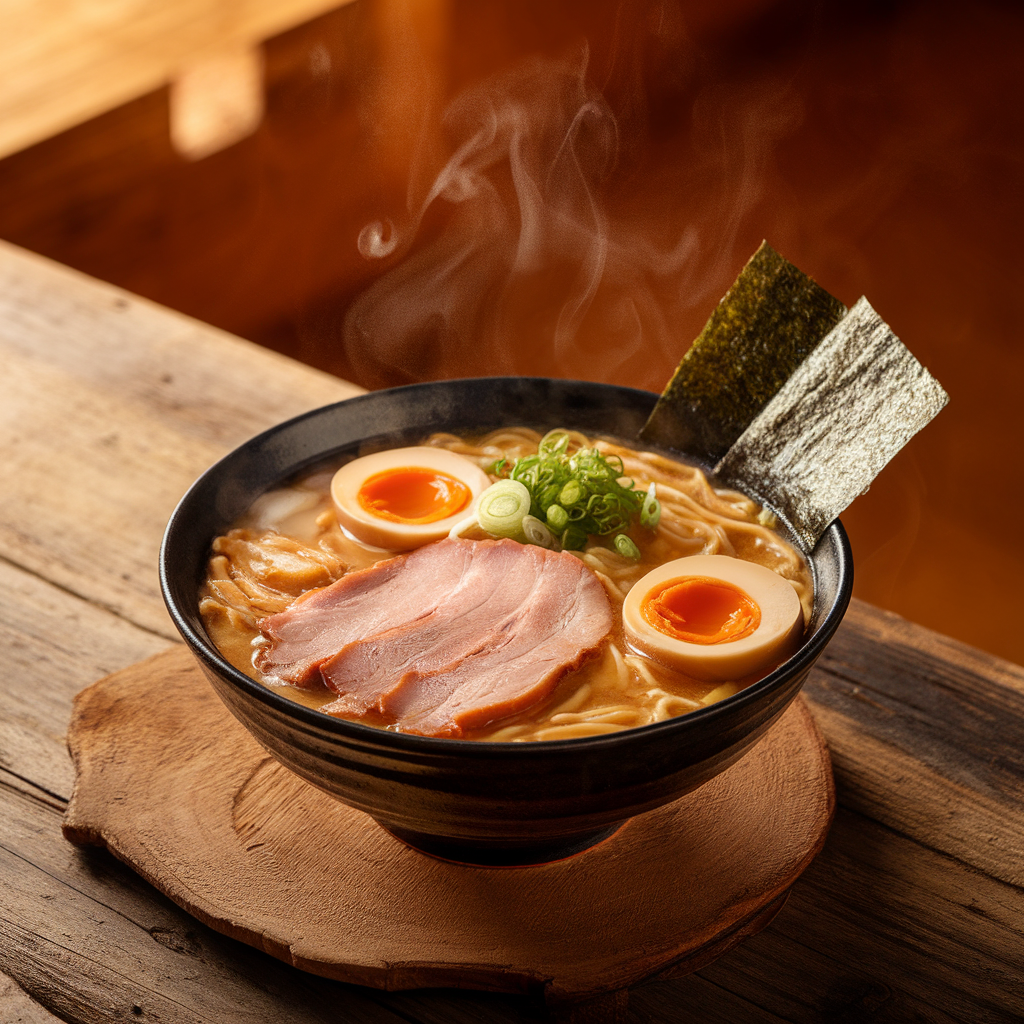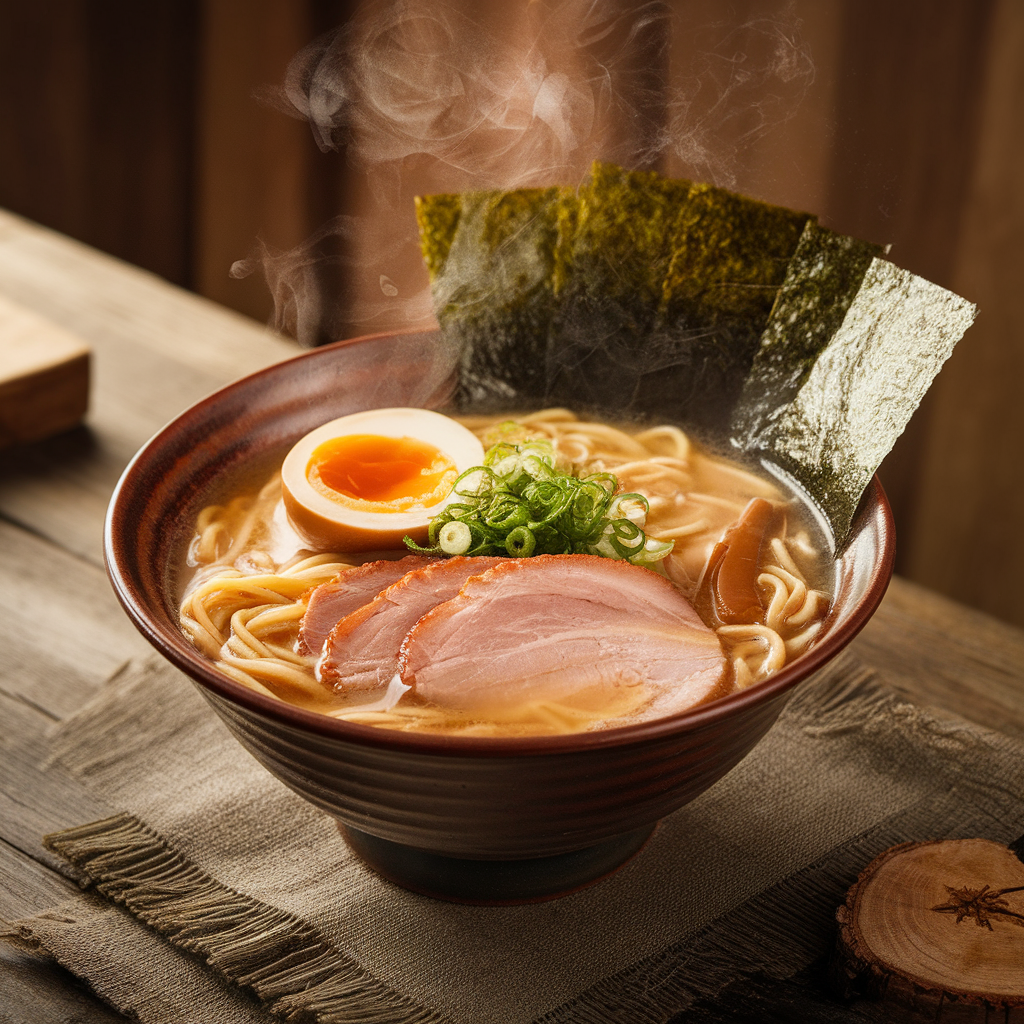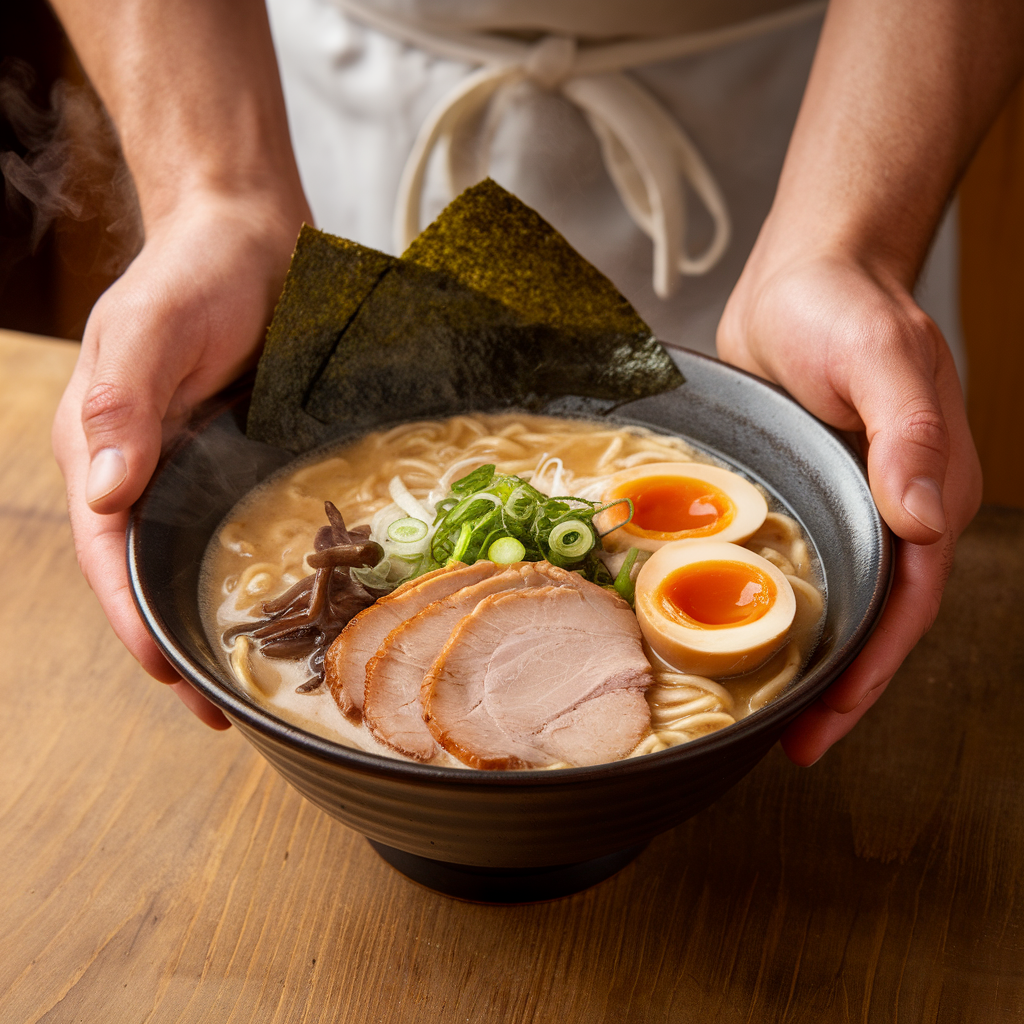There’s something magical about slurping down a hot bowl of ramen—the comfort, the umami-rich depth, the chewy noodles, and the medley of toppings. Among all the regional varieties of ramen in Japan, Tonkotsu Ramen stands as the king of richness and flavor.
In this article, we dive deep into the savory, collagen-rich world of tonkotsu ramen. You’ll learn about its origins, how to make it authentically from scratch, how to customize it to your taste, and why this dish has become a global obsession. Whether you’re a die-hard Japanese food fan, a noodle connoisseur, or a home cook looking to explore the bold side of Asian lunch food, this guide has you covered.
📜 The Origins of Tonkotsu Ramen
Tonkotsu ramen was born in Fukuoka, on Japan’s southern island of Kyushu, specifically in the Hakata district. It started as a cheap, filling meal for laborers—boiled pork bones, a handful of noodles, and little else. But over the decades, it evolved into one of the most beloved styles of ramen.
Unlike other ramen types like shoyu (soy sauce) or miso, tonkotsu’s main flavor comes from the broth itself, not a seasoning base. It’s made by boiling pork bones over high heat for 12–18 hours until the collagen and marrow emulsify into a rich, opaque soup. The technique requires patience and precision, making it the most labor-intensive and indulgent ramen.
Today, it’s a highlight in ramen shops across Japan and around the world, praised for its silky texture, intense umami flavor, and Instagram-worthy presentation—perfect for food dishes photography.
🍜 What Makes Tonkotsu Ramen Unique?
Tonkotsu ramen is all about depth and richness. It’s the kind of bowl that clings to your spoon and stays with you long after the meal.
Here’s why it’s one of the best Japanese food experiences:
- White, Milky Broth: Made by boiling pork bones for hours, resulting in a cloudy, creamy texture.
- Bold Pork Flavor: No other ramen style delivers the same savory punch.
- Thin, Firm Noodles: The noodles are typically straight and firm, offering a perfect contrast to the heavy broth.
- Iconic Toppings: Think chashu pork, marinated soft-boiled eggs, bamboo shoots, scallions, sesame seeds, and nori.

🛒 Ingredients: What You’ll Need for Authentic Tonkotsu Ramen
Creating ramen at home may seem daunting, but it’s deeply rewarding. Below are the core components you need to build a bowl from scratch:
🦴 For the Broth (Tonkotsu Stock):
- 5 lbs pork bones (neck, femur, or leg bones with marrow)
- 1 onion, peeled and halved
- 1 garlic bulb, halved crosswise
- 1 small knob of ginger, sliced
- 2 scallions (green onions)
- Water (enough to keep the bones submerged)
🍖 For Chashu Pork:
- 1–1.5 lbs pork belly (rolled and tied with butcher’s twine)
- ½ cup soy sauce
- ½ cup mirin
- ½ cup sake
- ½ cup water
- 3 dientes de ajo
- 1 small knob ginger
- 1 tablespoon sugar
🥚 For Ajitsuke Tamago (Marinated Eggs):
- 4 huevos grandes
- ½ cup soy sauce
- ½ cup mirin
- ½ cup water
🧂 For the Tare (Seasoning Sauce):
- 3 tablespoons soy sauce
- 1 tablespoon mirin
- 1 teaspoon rice vinegar
- Optional: Bonito flakes or anchovy extract for umami
🍜 For Assembly & Toppings:
- Fresh ramen noodles (or quality dried noodles)
- Nori sheets
- Sliced scallions
- Menma (bamboo shoots)
- Las semillas de sésamo
- Chili oil, garlic oil, or black garlic oil
- Pickled ginger (beni shoga)

🔪 Step-by-Step Instructions
Let’s break down the process into digestible parts. This version is fully authentic and will yield 4–6 restaurant-quality servings.
1. Prepare the Tonkotsu Broth
Time: 12–18 hours (yes, it’s worth it!)
Pro Tip: Do this a day before serving.
🧼 A. Clean the Bones
- Place pork bones in a large stock pot.
- Cover with water and bring to a rolling boil for 10–15 minutes.
- Drain and scrub bones under cold water to remove impurities.
🔥 B. Simmer for Richness
- Return bones to a clean pot and add fresh water, onions, garlic, ginger, and scallions.
- Boil aggressively for 12–18 hours, uncovered. Skim foam periodically.
- Add water as needed to keep bones submerged.
- Strain broth into a new pot. Optional: Blend some of the bones and broth together for added creaminess.
2. Make the Chashu Pork
While the broth simmers, make your pork belly:
- Combine soy sauce, mirin, sake, sugar, water, garlic, and ginger in a pot.
- Add rolled pork belly and bring to a boil.
- Simmer for 90 minutes, turning occasionally.
- Remove and let cool. Slice thinly before serving.
- Save the braising liquid—it’s perfect for marinating your eggs or adding depth to broth.
3. Marinate the Eggs
- Soft boil eggs for 6 minutes. Transfer to an ice bath.
- Peel gently and place in a ziplock bag with soy sauce, mirin, and water.
- Marinate for at least 4 hours or overnight.
4. Cook the Noodles
Boil fresh ramen noodles in unsalted water according to package directions (2–3 minutes max). Drain and set aside.

🍽️ Final Assembly
Time to build your bowl!
- Spoon 1–2 tbsp of tare into each bowl.
- Add hot tonkotsu broth.
- Add noodles.
- Top with:
- Sliced chashu pork
- Halved marinated eggs
- Chopped scallions
- Menma
- Nori
- Las semillas de sésamo
- Drizzle of chili or black garlic oil
Serve piping hot!
🔄 Ramen Customization Ideas
Tonkotsu ramen can be tailored to suit any taste.
💡 Add-Ins:
- Butter & Corn: Hokkaido-style twist
- Spicy Miso Paste: Adds another umami layer
- Kimchi: For fermented heat
- Shredded Cabbage: For texture and balance
🌱 Vegetarian Twist:
- Use soy milk and mushrooms to mimic the creamy texture
- Tofu chashu for protein
- Kombu-dashi base with miso tare
📷 Ramen and Food Photography
Tonkotsu ramen isn’t just delicious—it’s visually stunning. To capture it for social media or a blog:
- Use natural lighting and a dark wood or neutral-toned background
- Top with bright green scallions or red pickled ginger for contrast
- Style the egg yolk facing up for that gooey, golden shot
Perfect for trending tags like #FoodDishesPhotography y #GoodJapaneseFood!
🌍 Cultural Connection: The Ramen Craze
Ramen represents Japan’s modern culinary innovation—a blend of Chinese origins with regional flair. Tonkotsu ramen stands out globally, especially in ramen shops in Los Angeles, Tokyo, Sydney, and London.
Why is it so universally adored?
- Comfort in a bowl
- Depth of flavor
- Endless customizations
- The slurping culture itself—loud, proud, and joyful!
🍶 What to Serve With Tonkotsu Ramen
Complete your ramen night with:
- Gyoza (Japanese Dumplings)
- Edamame with Sea Salt
- Japanese Pickles (Tsukemono)
- Chilled Barley Tea (Mugicha)
- Green Tea or Sake
Planning an Asian lunch food menu? Tonkotsu ramen is the showstopper.
❄️ Storage and Reheating
- Broth: Refrigerate up to 5 days or freeze for 3 months.
- Fideos: Cook only what you need. Never store cooked noodles in broth.
- Chashu: Slice and freeze with marinade or broth.
- Los huevos: Best consumed within 3 days.
❤️ Why You’ll Love Tonkotsu Ramen
This dish is:
- A soul-satisfying comfort meal
- Perfect for cold days or indulgent weekends
- A crowd-pleaser for family or guests
- A must for anyone exploring Japanese food noodles
Once you make it from scratch, you’ll never look at ramen the same way again.
📝 Final Thoughts
Tonkotsu ramen is more than a dish—it’s a culinary experience, an art form, and a reflection of dedication to slow food in a fast world. From its humble beginnings in Fukuoka to global stardom, it remains one of Japan’s most flavorful exports.
Take your time, enjoy the process, and indulge in every slurp. This is ramen in its richest, most glorious form.
Ready to dive in? Gather your bones, tie your apron, and get ready to make a bowl that speaks to your soul. 🍜


